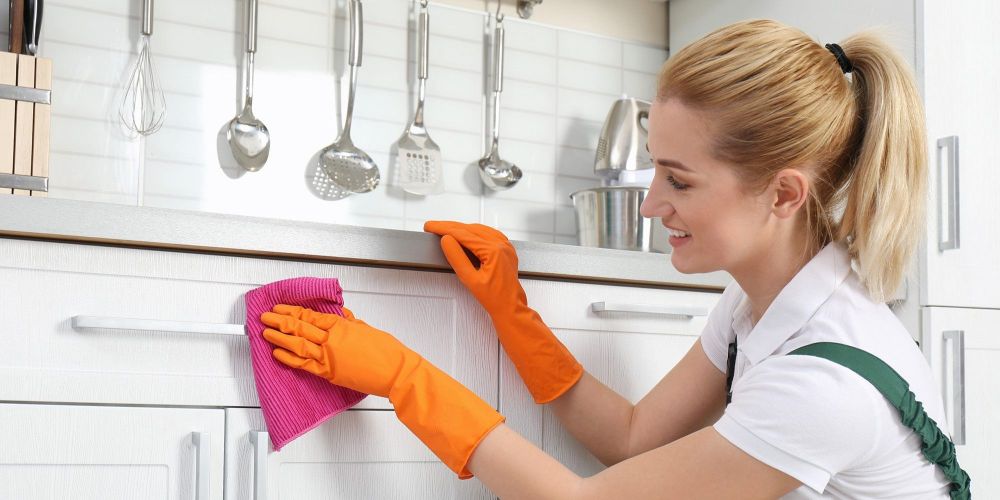Kitchen cupboard doors are prone to accumulating dirt, grease, and fingerprints over time. Regular cleaning not only keeps them looking fresh and beautiful but also helps prolong their lifespan. However, different types of cupboard doors require specific cleaning methods to ensure their finish remains intact. In this article, we will guide you through the process of cleaning various kitchen cupboard door types, including painted doors, wood doors, textured doors, and gloss doors. Let's dive in and discover how to restore the sparkle to your kitchen cabinets!
Why do kitchen doors get so dirty?
Kitchen units often accumulate dirt and grease through cooking and food preparation. Here are some reasons why kitchen doors tend to get greasy:
- Cooking Fumes: While cooking, especially when using oils or frying food, microscopic particles and vapours are released into the air. These cooking fumes contain oils, fats, and other substances that can settle on surfaces, including kitchen units, causing a greasy buildup over time.
- Splatters and Spills: During food preparation, it's common for liquids, oils, sauces, and ingredients to splatter or spill onto nearby surfaces, such as kitchen units. These splatters can quickly accumulate and leave greasy stains and residue.
- Lack of Ventilation: Inadequate ventilation in the kitchen can exacerbate the issue. Without proper airflow, cooking fumes and particles remain trapped in the kitchen, increasing the likelihood of grease settling on surfaces, including kitchen units.
- Proximity to Cooking Areas: Kitchen doors located near stoves, ovens, or grills are more susceptible to grease buildup. The closer they are to the cooking area, the more likely they are to come into contact with airborne grease particles and splatters.
- Neglected Cleaning: Irregular or improper cleaning practices contribute to grease buildup on kitchen cabinets. If surfaces are not cleaned regularly or effectively, the grease accumulates and becomes more challenging to remove over time.
- Absorbent Surfaces: Some kitchen units have porous or textured surfaces that are more prone to absorbing grease. This makes it easier for grease to penetrate the surface and become ingrained, making it harder to clean.
- Overuse of Oil or Cooking Fat: Excessive use of oil or cooking fat can result in more grease being released into the air during cooking. This increases the chances of grease settling on kitchen doors, drawer fronts and other surfaces.
- Cooking Methods: Certain cooking methods, such as frying or deep-frying, tend to produce more grease and splatters compared to others. These methods generate more airborne particles that can settle on kitchen units.
How to clean different types of kitchen door
This guide will walk you through the process of cleaning various kitchen cupboard door types, including painted doors, wood doors, textured doors, and gloss doors. Let's dive in and discover how to restore the sparkle to your kitchen cabinets!
How to clean painted kitchen doors
Painted kitchen doors require gentle cleaning to prevent any damage to the paintwork. Follow these steps for a thorough yet safe cleaning routine:
- Prepare a Cleaning Solution: Mix mild dish soap with warm water in a bucket or basin. Avoid using abrasive cleaners or harsh chemicals as they may strip the paint or cause discoloration.
- Wipe Down the Doors: Dip a soft microfiber cloth or sponge into the soapy solution, wring out excess moisture, and gently wipe down the painted doors. Pay attention to areas prone to grease buildup, such as near the stove or handles. Be careful not to scrub vigorously to prevent scratching the paint.
- Rinse and Dry: After cleaning, dampen another cloth with clean water and wipe away any soapy residue from the doors. Finally, dry the doors thoroughly using a soft, lint-free cloth.
How to clean wooden kitchen doors
Wooden cupboard doors require special care to preserve their natural beauty. Follow these steps to clean and maintain the lustre of your wood doors:
- Dusting: Start by removing any loose dust or debris from the doors using a soft, dry cloth or a feather duster. This prevents scratching the surface during the cleaning process.
- Mild Cleaning Solution: Prepare a mixture of warm water and a gentle wood cleaner or a few drops of mild dish soap. Avoid using excessive water or harsh chemicals as they can damage the wood finish.
- Gentle Cleaning: Dip a clean cloth or sponge into the cleaning solution, wring out excess liquid, and gently wipe the doors along the wood grain. Be cautious not to oversaturate the wood. For stubborn stains, apply a small amount of the cleaning solution directly to the stain and gently rub it with a soft cloth.
- Rinse and Dry: Using a damp cloth, remove any soapy residue from the doors. Immediately dry the doors with a soft, dry cloth to prevent water damage and ensure a streak-free finish.
How to clean textured doors
Wooden cupboard doors require special care to preserve their natural beauty. Follow these steps to clean and maintain the lustre of your wood doors:
- Dusting: Start by removing any loose dust or debris from the doors using a soft, dry cloth or a feather duster. This prevents scratching the surface during the cleaning process.
- Mild Cleaning Solution: Prepare a mixture of warm water and a gentle wood cleaner or a few drops of mild dish soap. Avoid using excessive water or harsh chemicals as they can damage the wood finish.
- Gentle Cleaning: Dip a clean cloth or sponge into the cleaning solution, wring out excess liquid, and gently wipe the doors along the wood grain. Be cautious not to oversaturate the wood. For stubborn stains, apply a small amount of the cleaning solution directly to the stain and gently rub it with a soft cloth.
- Rinse and Dry: Using a damp cloth, remove any soapy residue from the doors. Immediately dry the doors with a soft, dry cloth to prevent water damage and ensure a streak-free finish.
How to clean laminate kitchen doors
Laminate cupboard doors provide a sleek and modern look to the kitchen but require careful cleaning to maintain their shine, as they are prone to smudge marks. Follow these steps to clean and maintain the glossy finish:
- Dusting: Start by dusting the doors with a soft, dry cloth or a microfiber duster to remove any loose debris or particles.
- Gentle Cleaning Solution: Prepare a mixture of warm water and a mild, non-abrasive cleaner specifically designed for glossy surfaces. Avoid using abrasive cleaners or rough materials that may scratch the glossy laminate finish.
- Wipe Down the Doors: Dip a soft microfiber cloth or sponge into the cleaning solution, wring out excess moisture, and gently wipe the glossy doors. Work in small sections, ensuring complete coverage. Avoid using excessive pressure or scrubbing motions that can damage the gloss.
- Rinse and Dry: Using a clean cloth dampened with water, remove any residual cleaning solution from the doors. Finally, dry the doors thoroughly using a soft, lint-free cloth to achieve a streak-free, shiny finish.
How to clean white kitchen doors
Wooden cupboard doors require special care to preserve their natural beauty. Follow these steps to clean and maintain the lustre of your wood doors:
- Dusting: Start by removing any loose dust or debris from the doors using a soft, dry cloth or a feather duster. This prevents scratching the surface during the cleaning process.
- Mild Cleaning Solution: Prepare a mixture of warm water and a gentle wood cleaner or a few drops of mild dish soap. Avoid using excessive water or harsh chemicals as they can damage the wood finish.
- Gentle Cleaning: Dip a clean cloth or sponge into the cleaning solution, wring out excess liquid, and gently wipe the doors along the wood grain. Be cautious not to oversaturate the wood. For stubborn stains, apply a small amount of the cleaning solution directly to the stain and gently rub it with a soft cloth.
- Rinse and Dry: Using a damp cloth, remove any soapy residue from the doors. Immediately dry the doors with a soft, dry cloth to prevent water damage and ensure a streak-free finish.
Frequently Asked Questions
How often should I clean my kitchen doors?
It is recommended to clean kitchen doors regularly as part of your cleaning routine. Depending on the level of use and buildup, cleaning them once every few weeks or once a month is a good starting point. However, you may need to clean them more frequently if there are visible stains, grease, or spills.
What cleaning products are safe to use on kitchen doors?
Mild and non-abrasive cleaning products are generally safe to use on kitchen doors. Common options include dish soap, warm water, diluted all-purpose cleaners, or specialised kitchen cleaners formulated for door surfaces. Always check the manufacturer's instructions for any specific product recommendations.
How do I remove stubborn stains from kitchen doors?
For stubborn stains, create a paste using baking soda and water. Apply the paste to the stained area, let it sit for a few minutes, then gently scrub with a soft cloth or sponge. Rinse with clean water and dry completely.
How do I prevent grease buildup on kitchen doors?
To prevent grease buildup, ensure proper ventilation in your kitchen to reduce cooking fumes and airborne particles. Wipe down kitchen doors regularly, especially near cooking areas, to remove any grease or splatters. Using range hoods or exhaust fans while cooking can also help minimize grease accumulation.
Can I use vinegar to clean kitchen doors?
Vinegar can be used to clean kitchen doors in some cases. However, it is important to note that vinegar is acidic and may not be suitable for all types of doors. Test a small, inconspicuous area first to ensure it doesn't damage the door's surface.
Are there any natural or homemade cleaning solutions for kitchen doors?
Yes, there are natural or homemade cleaning solutions you can use. Some examples include a mixture of vinegar and water, baking soda paste, or lemon juice diluted with water. These solutions can be effective for general cleaning and stain removal, but always test them in an inconspicuous area first.
Regular cleaning of kitchen cupboard doors is essential to maintain their appearance and durability. By following the appropriate cleaning methods for different types of cupboard doors—such as painted doors, wood doors, textured doors, and gloss doors—you can keep them looking their best for years to come. Remember to always use gentle cleaning solutions, avoid abrasive materials, and dry the doors thoroughly to ensure a spotless and pristine kitchen cabinet display. Happy cleaning!




